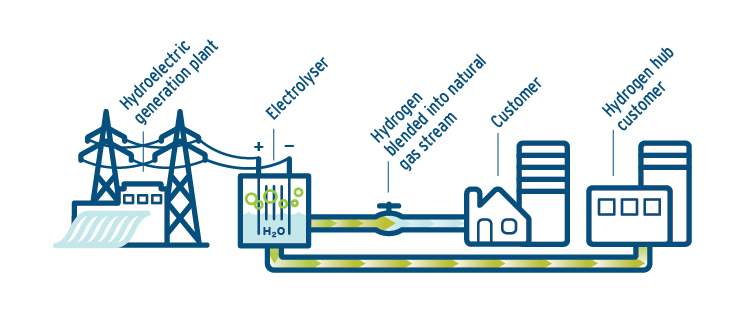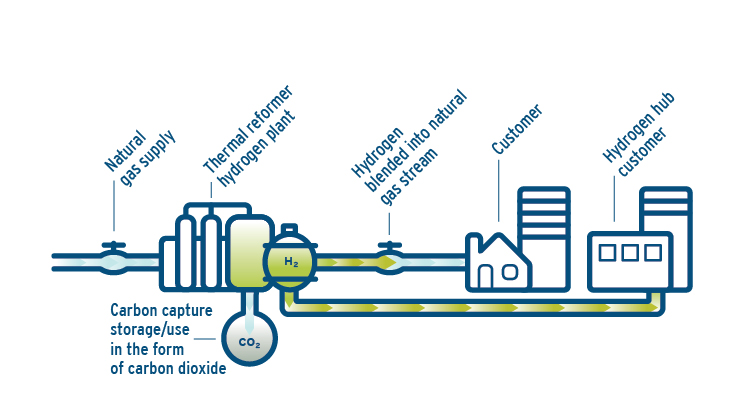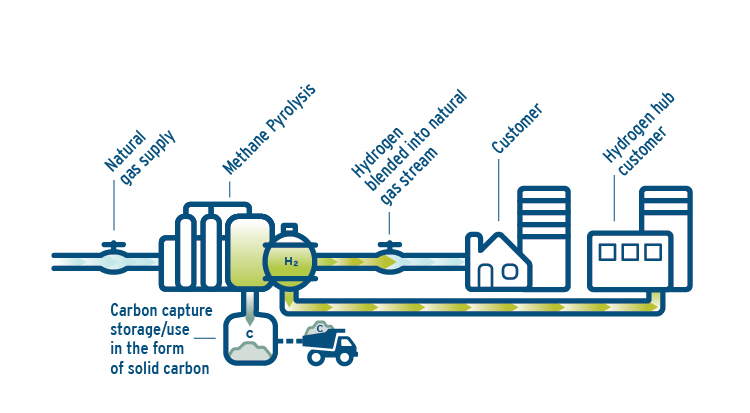Hydrogen gas
Hydrogen gas holds exciting potential as a lower carbon energy.1 We expect that hydrogen will play a role in expanding FortisBC’s portfolio of renewable and lower carbon energy. It’s another way we’re supporting the province’s CleanBC strategy.
What is hydrogen gas and how is it made?
Hydrogen gas is colourless, odourless and tasteless, just like natural gas. It emits no carbon dioxide when used for energy.
FortisBC is currently exploring three different ways to produce hydrogen:
Green hydrogen
Hydrogen and oxygen atoms are separated from water through electrolysis powered by renewable electricity.

Blue hydrogen
Blue hydrogen has carbon captured as carbon dioxide and stored as gas.

Turquoise hydrogen
Turquoise hydrogen has carbon captured as a solid substance that can either be stored or used by other industries.

While we’re currently exploring green, blue and turquoise hydrogen, we are also exploring accessing hydrogen byproduct from industrial processes that gets vented to the atmosphere. Instead, this hydrogen byproduct can be captured and used as an energy source.
Helping lower emissions
We continue to acquire renewable and lower carbon gas,2 including Renewable Natural Gas3 (RNG) to support provincial climate action targets. In 2024, we acquired 2.8 petajoules of RNG for our customers,4 which is enough energy for more than 31,000 homes for a year.5
Hydrogen offers exciting new possibilities, including blending hydrogen with natural gas to lower emissions and using hydrogen in certain industrial settings or in fuel cells for transportation. As a gaseous energy, hydrogen offers many of the same advantages as natural gas (such as simple and affordable storage) but emits no carbon dioxide when used for energy.
Building a hydrogen industry in BC
The B.C. government has taken several actions to encourage the growth of a hydrogen industry, including the announcement of the provincial hydrogen strategy, a blueprint for how renewable and lower carbon hydrogen could support provincial climate goals and create new jobs in B.C.
FortisBC plans to be an important part of a hydrogen industry in B.C.—both in potentially helping to develop production capacity and in providing the necessary transportation infrastructure and expertise needed to make hydrogen production and use economical.
We’re working with industry leaders to share knowledge and set best practices in hydrogen production, distribution and end-use. FortisBC is a member of Hydrogen BC (a branch of The Canadian Hydrogen and Fuel Cell Association) and an active supporter of and participant in HyDeal LA–one of the most ambitious hydrogen projects in the world.
We’re working with the University of British Columbia’s Okanagan campus and multiple other post-secondary institutions and international joint industry programs to study how to safely integrate hydrogen into our natural gas system.
Supporting the energy transition
We believe that hydrogen has the potential to play a role in a lower carbon energy future and can help support the goals of the province’s CleanBC strategy.
A study we commissioned with the BC Bioenergy Network and the Province of British Columbia shows the province holds a wealth of potential to make renewable and lower carbon gases, and hydrogen is the single largest potential source.
Learn more about all the ways we’re working to help our customers lower overall emissions.
1FortisBC uses the term renewable and lower carbon energy to refer collectively to electricity and the lower carbon gases or fuels that the utility can acquire under the Greenhouse Gas Reduction (Clean Energy) Regulation, which are: Renewable
Natural Gas (also called RNG or biomethane), hydrogen, synthesis gas (from wood waste) and lignin. FortisBC’s renewable and lower carbon gas portfolio currently includes only Renewable Natural Gas. Other gases and fuels may be added to the program
over time. Depending on their source, all of these gases have differing levels of lifecycle carbon intensity. However, all of these gases are lower carbon when compared to the lifecycle carbon intensity of conventional natural gas. The current burner
tip emission factor of RNG is 0.27 grams of carbon dioxide equivalent per megajoule of energy (gCO2e/MJ) and the current renewable and lower carbon gas portfolio lifecycle emissions for stationary combustion are -22 gCO2e/MJ.
This is below B.C.’s lifecycle carbon intensity threshold of 30.8 gCO2e/MJ as set out in the 2024 Greenhouse Gas Reduction Regulation amendments.
2FortisBC uses the term renewable and lower carbon gas to refer collectively to the lower carbon gases or fuels that the utility can acquire under the
Greenhouse Gas Reduction (Clean Energy) Regulation, which are: Renewable Natural Gas (also called RNG or biomethane), hydrogen, synthesis gas (from wood waste) and lignin. FortisBC’s renewable and lower carbon gas portfolio currently includes
only Renewable Natural Gas. Other gases and fuels may be added to the program over time. Depending on their source, all of these gases have differing levels of lifecycle carbon intensity. However, all of these gases are lower carbon when compared
to the lifecycle carbon intensity of conventional natural gas. The current burner tip emission factor of RNG is 0.27 grams of carbon dioxide equivalent per megajoule of energy (gCO2e/MJ) and the current renewable and lower carbon gas portfolio
lifecycle emissions for stationary combustion are -22 gCO2e/MJ. This is below B.C.’s lifecycle carbon intensity threshold of 30.8 gCO2e/MJ as set out in the 2024 Greenhouse Gas Reduction Regulation amendments.
3Renewable Natural Gas (also called RNG or biomethane) is produced in a different manner than conventional natural gas. It is derived from biogas, which
is produced from decomposing organic waste from landfills, agricultural waste and wastewater from treatment facilities. The biogas is captured and cleaned to create RNG. When RNG is added to North America’s natural gas system, it mixes with
conventional natural gas. This means we’re unable to direct RNG to a specific customer. But the more RNG is added to the gas system, the less conventional natural gas is needed, thereby reducing the use of fossil fuels and overall greenhouse
gas emissions.
4Source: FortisBC 2024 Sustainability Report, page 15.
5Based on a typical residential gas customer with an average annual consumption of 90 gigajoules.